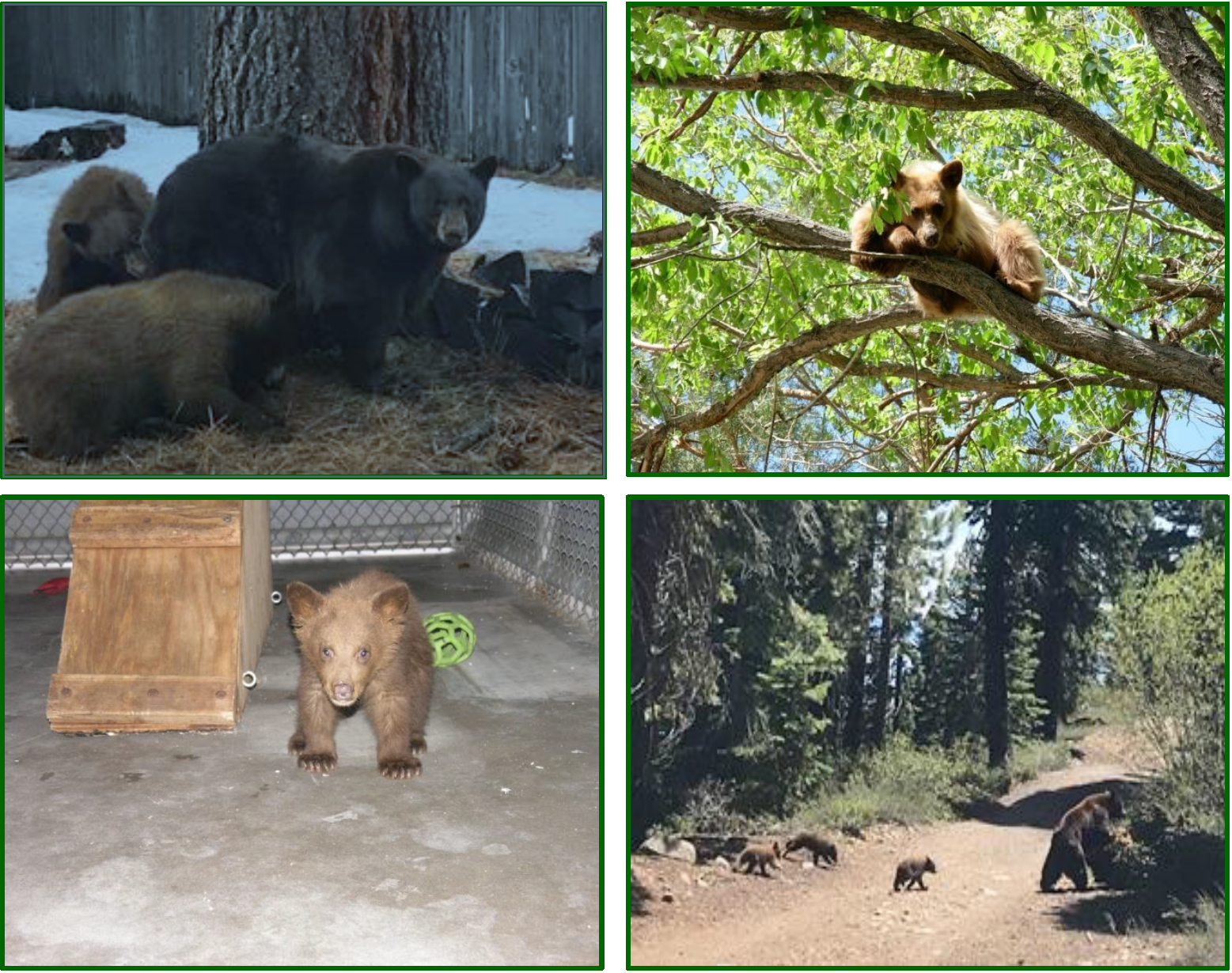May 29, 2021 - LAKE TAHOE, Calif./Nev. - For many, Memorial Day weekend is the traditional start of summer and with warmer weather and fewer Covid-19 restrictions, many campgrounds are opening and visitor numbers are increasing in the Lake Tahoe Basin. With this activity comes more human food, more garbage, and more people sharing space with bears.
This is also a time when some mother bears (sows) are accompanied by very small cubs, born in January or February. These cubs of the year are following their mothers to learn their way in the wild and will likely separate from the sow in one year. Other sows have yearlings with them that were born in winter dens over a year ago and are about to be cut loose by mom so she can search for a mate for the summer breeding cycle. These yearlings of variable sizes are well equipped to make it on their own.
Cubs of the year are dependent on their mothers and hopefully will be taught how to forage on natural vegetation, including grass, berries, grubs, and other wild bear foods. The sows may be protective of the cubs and people need to give them space. Never get in between a sow and her cubs. If you see a cub of the year alone, or up a tree for safety, the sow may not want to leave the area so back away and give them room to reunite.
This time of year, wildlife agencies receive many calls from people concerned that they have found an orphaned cub when they are actually seeing a yearling that is safely on its own. A good rule of thumb in knowing the difference is to look at the size of the bear. If the bear is the size of a cat (around 10-15 pounds), it is a new cub of the year and chances are the cub’s mom is somewhere nearby or may have put the cub up a tree while she goes to forage. Keep an eye on the cub and if you do not see mom after a couple of hours, please call the appropriate state wildlife agency below so they can send a wildlife expert out to assess the situation.
On occasion, there are situations in which a cub has truly been orphaned, which could result from a vehicle hit, or other cause of death of the sow. The proper state authorities, California Department of Wildlife (CDFW) or the Nevada Department of Wildlife (NDOW), should be called to evaluate the situation and safely transport the cub for evaluation and rehabilitation. Picking up a cub too soon or while mom is just around the corner can do a lot more harm than good. If the bear is the size of a medium-sized dog (45-plus pounds) then it is a yearling, and it is perfectly normal for it to be on its own. If you’re not sure, don’t hesitate to call your wildlife experts at CDFW, California State Parks or NDOW to ask.
Don’t teach these young bears to be comfortable around people! If they have gotten too close, make noise and try to scare them away so they don’t feel comfortable and want to stay. While it’s fun to see bears and even take pictures and videos, you’re telling the bear that it’s alright to be close to you. Bears are smart and acquire learned behaviors based on their experiences. If they have a negative, scary encounter with a human, chances are they will try to avoid them in the future. Allowing bears to become comfortable around people can lead to unwanted activity, including breaking into cars and houses or approaching people who are eating outdoors. It is illegal to feed bears both directly and indirectly by allowing them access to garbage or food.
This weekend and throughout the busy summer season, visitors will steadily increase and must be vigilant with food and trash storage whether at home, the beach, campgrounds, picnic areas or trailheads. Enjoy wildlife from a distance, and don’t attempt to handle young bears. With your help we can Keep Tahoe Bears Wild!
To report human-bear conflicts: In California, contact the CDFW at 916-358-2917, or report online using the Wildlife Incident Reporting (WIR) system at apps.wildlife.ca.gov/wir. Non-emergency wildlife interactions in California State Parks can be reported to public dispatch at 916-358-1300. In Nevada, contact NDOW at 775-688-BEAR (2327). For general questions, contact the following agency Public Information Officers: Peter Tira, CDFW; Ashley Sanchez, NDOW; or Lisa Herron, USDA Forest Service. If the issue is an immediate threat, call the local sheriff’s department or 911.
For more information on peacefully coexisting with bears, visit TahoeBears.org. TahoeBears.org is made possible through funding from NDOW.
This collaborative agency effort includes California Department of Fish and Wildlife, California State Parks, El Dorado County Sheriff’s Office, Nevada Department of Wildlife, Nevada State Parks, Placer County Sheriff’s Office, Tahoe Regional Planning Agency and the USDA Forest Service Lake Tahoe Basin Management Unit (LTBMU).

Photo captions/credit L-R: Black bear sow with yearlings (medium dog size) courtesy CDFW; Yearling on its own in tree (medium dog size) courtesy NDOW; Cub of the year (cat size) in a rehabilitation facility courtesy CDFW; and Sow with cubs of the year (cat size) courtesy David Braun, LTBMU.
Source: CA. State Parks








